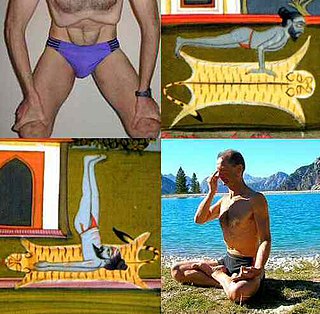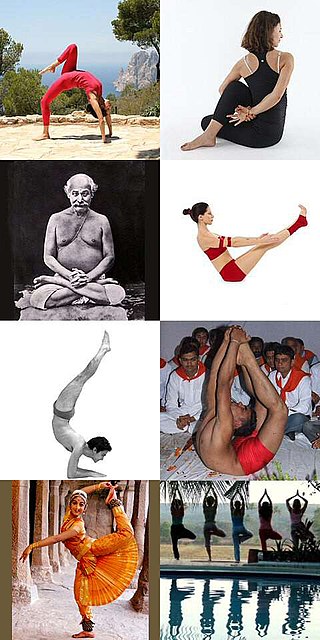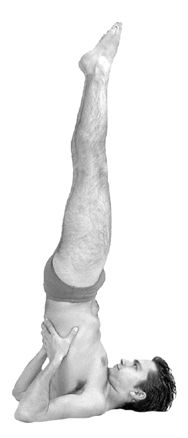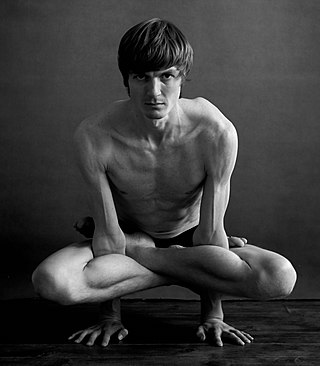
Hatha yoga is a branch of yoga that uses physical techniques to try to preserve and channel vital force or energy. The Sanskrit word हठ haṭha literally means "force", alluding to a system of physical techniques. Some hatha yoga style techniques can be traced back at least to the 1st-century CE, in texts such as the Hindu Sanskrit epics and Buddhism's Pali canon. The oldest dated text so far found to describe hatha yoga, the 11th-century Amṛtasiddhi, comes from a tantric Buddhist milieu. The oldest texts to use the terminology of hatha are also Vajrayana Buddhist. Hindu hatha yoga texts appear from the 11th century onward.

A mudra is a symbolic or ritual gesture or pose in Hinduism, Jainism and Buddhism. While some mudras involve the entire body, most are performed with the hands and fingers.

An āsana is a body posture, originally and still a general term for a sitting meditation pose, and later extended in hatha yoga and modern yoga as exercise, to any type of position, adding reclining, standing, inverted, twisting, and balancing poses. The Yoga Sutras of Patanjali define "asana" as "[a position that] is steady and comfortable". Patanjali mentions the ability to sit for extended periods as one of the eight limbs of his system. Asanas are also called yoga poses or yoga postures in English.

The Haṭha Yoga Pradīpikā is a classic fifteenth-century Sanskrit manual on haṭha yoga, written by Svātmārāma, who connects the teaching's lineage to Matsyendranath of the Nathas. It is among the most influential surviving texts on haṭha yoga, being one of the three classic texts alongside the Gheranda Samhita and the Shiva Samhita.

Gheranda Samhita is a Sanskrit text of Yoga in Hinduism. It is one of the three classic texts of hatha yoga, and one of the most encyclopedic treatises in yoga. Fourteen manuscripts of the text are known, which were discovered in a region stretching from Bengal to Rajasthan. The first critical edition was published in 1933 by Adyar Library, and the second critical edition was published in 1978 by Digambarji and Ghote. Some of the Sanskrit manuscripts contain ungrammatical and incoherent verses, and some cite older Sanskrit texts.

The shatkarmas, also known as shatkriyas, are a set of Hatha yoga purifications of the body, to prepare for the main work of yoga towards moksha (liberation). These practices, outlined by Svatmarama in the Haṭha Yoga Pradīpikā as kriya, are Netī, Dhautī, Naulī, Basti, Kapālabhātī, and Trāṭaka. The Haṭha Ratnavali mentions two additional purifications, Cakri and Gajakarani, criticising the Hatha Yoga Pradipika for only describing the other six.

Sarvangasana, Shoulder stand, or more fully Salamba Sarvangasana, is an inverted asana in modern yoga as exercise; similar poses were used in medieval hatha yoga as a mudra.

Kumbhaka is the retention of the breath in the yoga practice of pranayama. It has two types, accompanied whether after inhalation or after exhalation, and, the ultimate aim, unaccompanied. That state is kevala kumbhaka, the complete suspension of the breath for as long as the practitioner wishes.
Shiva Samhita is a Sanskrit text on yoga, written by an unknown author. The text is addressed by the Hindu ascetic Shiva to his consort Parvati. The text consists of five chapters, with the first chapter a treatise that summarizes nondual Vedanta philosophy with influences from the Sri Vidya school of South India. The remaining chapters discuss yoga, the importance of a guru (teacher) to a student, various asanas, mudras and tantra.

Basti is an important shatkarma, a yogic purification, intended to clean the lower abdomen, especially the colon. The Hatha Yoga Pradipika and other sources attribute to it many beneficial effects. There are two ways to perform Basti:

Kukkutasana, Cockerel Pose, or Rooster Posture is an arm-balancing asana in hatha yoga and modern yoga as exercise, derived from the seated Padmasana, lotus position. It is one of the oldest non-seated asanas. Similar hand-balancing poses known from the 20th century include Pendant Pose or Lolasana, and Scale Pose or Tulasana.

Matsyendrasana, Matsyendra's Pose or Lord of the Fishes Pose is a seated twisting asana in hatha yoga and modern yoga as exercise. The full form is the difficult Paripurna Matsyendrasana. A common and easier variant is Ardha Matsyendrasana. The asana has many variations, and in its half form is one of the twelve basic asanas in many systems of hatha yoga.

Ashtanga Namaskara, Ashtanga Dandavat Pranam, Eight Limbed pose, Caterpillar pose, or Chest, Knees and Chin pose is an asana sometimes used in the Surya Namaskar sequence in modern yoga as exercise, where the body is balanced on eight points of contact with the floor: feet, knees, chest, chin and hands.

Gorakshasana is a seated asana in hatha yoga. It has been used for meditation and in tantric practice.
Vajroli mudra, the Vajroli Seal, is a practice in Hatha yoga which requires the yogi to preserve his semen, either by learning not to release it, or if released by drawing it up through his urethra from the vagina of "a woman devoted to the practice of yoga".

Yoga Makaranda, meaning "Essence of Yoga", is a 1934 book on hatha yoga by the influential pioneer of yoga as exercise, Tirumalai Krishnamacharya. Most of the text is a description of 42 asanas accompanied by 95 photographs of Krishnamacharya and his students executing the poses. There is a brief account of practices other than asanas, which form just one of the eight limbs of classical yoga, that Krishnamacharya "did not instruct his students to practice".

Hatha Yoga: The Report of a Personal Experience is a 1943 book by Theos Casimir Bernard describing what he learnt of hatha yoga, ostensibly in India. It is one of the first books in English to describe and illustrate a substantial number of yoga poses (asanas); it describes the yoga purifications (shatkarmas), yoga breathing (pranayama), yogic seals (mudras), and meditative union (samadhi) at a comparable level of detail.

The standing asanas are the yoga poses or asanas with one or both feet on the ground, and the body more or less upright. They are among the most distinctive features of modern yoga as exercise. Until the 20th century there were very few of these, the best example being Vrikshasana, Tree Pose. From the time of Krishnamacharya in Mysore, many standing poses have been created. Two major sources of these asanas have been identified: the exercise sequence Surya Namaskar ; and the gymnastics widely practised in India at the time, based on the prevailing physical culture.
The Dattātreyayogaśāstra, a Vaisnava text probably composed in the 13th century CE, is the earliest text which provides a systematized form of Haṭha yoga under that name, and the earliest to place its yoga techniques under the name Haṭha.
















